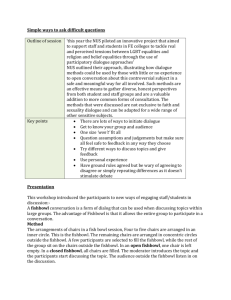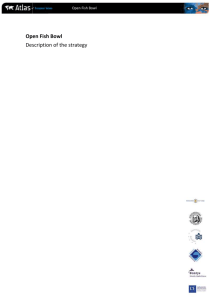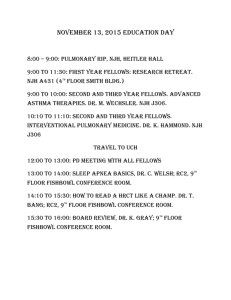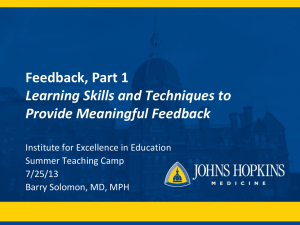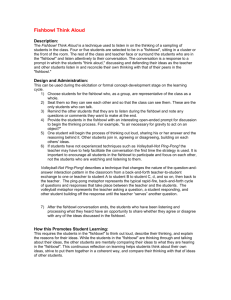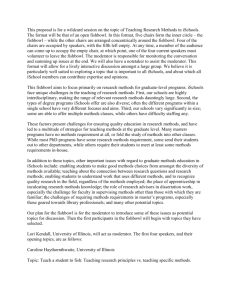Lesson and/or Unit Title: Module 3a Unit 1: Lesson 13 Building
advertisement
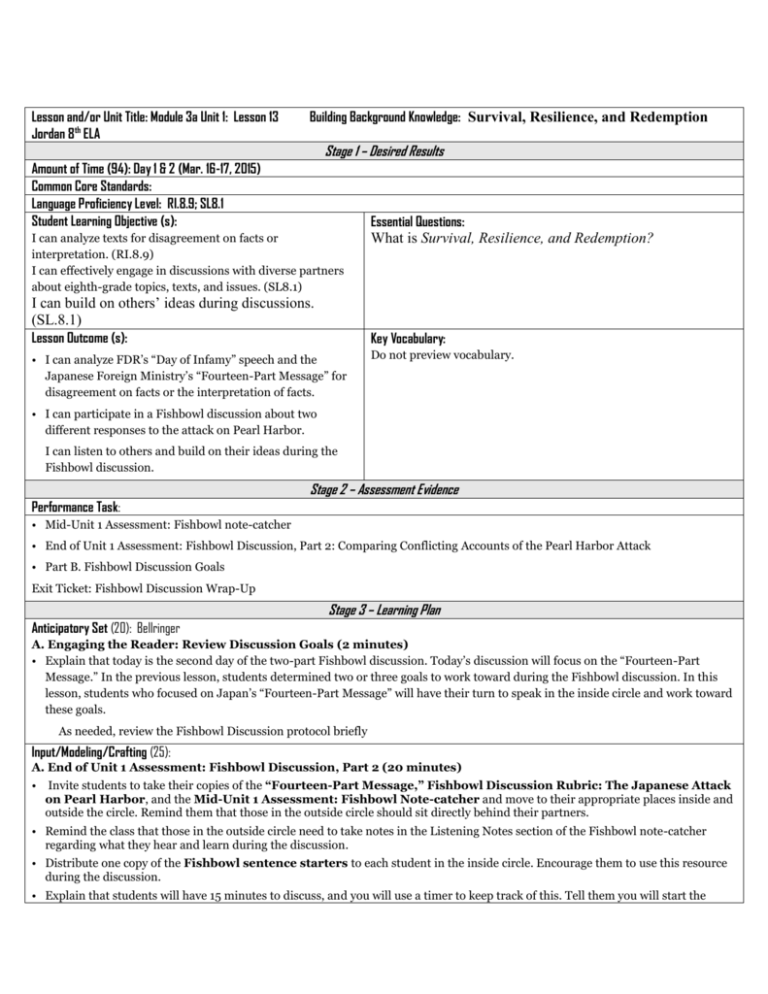
Lesson and/or Unit Title: Module 3a Unit 1: Lesson 13 Jordan 8th ELA Building Background Knowledge: Survival, Resilience, and Redemption Stage 1 – Desired Results Amount of Time (94): Day 1 & 2 (Mar. 16-17, 2015) Common Core Standards: Language Proficiency Level: RI.8.9; SL8.1 Student Learning Objective (s): Essential Questions: I can analyze texts for disagreement on facts or interpretation. (RI.8.9) I can effectively engage in discussions with diverse partners about eighth-grade topics, texts, and issues. (SL8.1) What is Survival, Resilience, and Redemption? I can build on others’ ideas during discussions. (SL.8.1) Lesson Outcome (s): Key Vocabulary: • I can analyze FDR’s “Day of Infamy” speech and the Japanese Foreign Ministry’s “Fourteen-Part Message” for disagreement on facts or the interpretation of facts. Do not preview vocabulary. • I can participate in a Fishbowl discussion about two different responses to the attack on Pearl Harbor. I can listen to others and build on their ideas during the Fishbowl discussion. Stage 2 – Assessment Evidence Performance Task: • Mid-Unit 1 Assessment: Fishbowl note-catcher • End of Unit 1 Assessment: Fishbowl Discussion, Part 2: Comparing Conflicting Accounts of the Pearl Harbor Attack • Part B. Fishbowl Discussion Goals Exit Ticket: Fishbowl Discussion Wrap-Up Stage 3 – Learning Plan Anticipatory Set (20): Bellringer A. Engaging the Reader: Review Discussion Goals (2 minutes) • Explain that today is the second day of the two-part Fishbowl discussion. Today’s discussion will focus on the “Fourteen-Part Message.” In the previous lesson, students determined two or three goals to work toward during the Fishbowl discussion. In this lesson, students who focused on Japan’s “Fourteen-Part Message” will have their turn to speak in the inside circle and work toward these goals. As needed, review the Fishbowl Discussion protocol briefly Input/Modeling/Crafting (25): A. End of Unit 1 Assessment: Fishbowl Discussion, Part 2 (20 minutes) • Invite students to take their copies of the “Fourteen-Part Message,” Fishbowl Discussion Rubric: The Japanese Attack on Pearl Harbor, and the Mid-Unit 1 Assessment: Fishbowl Note-catcher and move to their appropriate places inside and outside the circle. Remind them that those in the outside circle should sit directly behind their partners. • Remind the class that those in the outside circle need to take notes in the Listening Notes section of the Fishbowl note-catcher regarding what they hear and learn during the discussion. • Distribute one copy of the Fishbowl sentence starters to each student in the inside circle. Encourage them to use this resource during the discussion. • Explain that students will have 15 minutes to discuss, and you will use a timer to keep track of this. Tell them you will start the discussion by asking some questions, but they should focus on talking to each other, rather than just answering your questions. • Distribute the End of Unit 1 Assessment: Fishbowl Discussion, Part 2: Comparing Conflicting Accounts of the Pearl Harbor Attack to each student and display a copy using a document camera. • Set the timer for 15 minutes and begin the discussion by asking: * “From your perspective, what was the gist of this text?” • After a few students have shared their understanding of the text’s gist, ask: * “What did the Japanese government accuse the United States of doing?” * “What was the Japanese government’s perspective on the Pearl Harbor attack?” • Encourage all students to respond to the questions using evidence from their Fishbowl note-catcher and the text. • Choose from the following questions to engage students further in the discussion. If the discussion runs out of steam at any point, return to this list of questions and ask a new one to keep students thinking: * “What key facts did the Japanese use in this text? How were each of these facts interpreted?” * “Were there any facts that the Japanese government omitted?” “What questions do you have for other people in the circle about their understanding of this text?” Guided Practice (20): B. Fishbowl Debrief, Part 2 (10 minutes) • Give students in the outside circle 3 minutes to complete their Listening Notes. While they are doing this, direct students sitting in the inside circle to the Self-Reflection portion of the Fishbowl Discussion rubric. Ask them to think about and record things they did well during the discussion and things they could improve upon for future discussions. • Tell students to meet with their partner. Give them 2 minutes for the person in the outside circle to share reflections on what they heard/learned during the discussion and 2 minutes for the person in the inside circle to share reflections. • Ask students to turn and talk to their partner: * “What are the overall differences in perspectives?” Cold call two or three student pairs to share their ideas. Independent Practice (10): A. Exit Ticket: Fishbowl Discussion Wrap-Up (12 minutes) As a closing piece to the Fishbowl discussion, have students complete the Exit Ticket: Fishbowl Discussion Wrap-Up. Closure (15): Read AR books B. As time permits, invite students to share out whole group. Preview Homework (1 minute) • As time permits, invite students to share out whole group. Preview Homework (1 minute) Distribute Unbroken structured notes, pages 147–168. Let students know they should complete their reading assignments in Unbroken, read the summaries provided for pages 141–147 and 156–166 in the structured notes, and complete the structured notes. Alignment Extension (Homework): Read the summary for pages 141–147 provided in the structured notes, then read pages 147–156 in Unbroken and record the gist. Next, read the summary provided for pages 156–166, then read 166–168 in the book and record the gist. Answer the focus question: “During Louie’s ordeal of being lost at sea, Hillenbrand writes of several occasions in which he experiences the presence of God. What are these experiences like, and how does he experience God in each of them?” Finish filling in the structured notes Differentiation Notes: Provide struggling learners with the supported structured notes for additional scaffolding as they read the novel. Materials/Items Needed • Fourteen-Part Message” (from Lesson 7; one per student) • Fishbowl Discussion Rubric: The Japanese Attack on Pearl Harbor (from Lesson 12; one per student) • Mid-Unit 1 Assessment: Fishbowl Note-catcher (from Lesson 10; returned in Lesson 12 with teacher feedback) • Fishbowl sentence starters (from Lesson 12; one per student in inside circle) • End of Unit 1 Assessment: Fishbowl Discussion, Part 2: Comparing Conflicting Accounts of the Pearl Harbor Attack (one per student and one for display) • Document camera • Timer • Exit Ticket: Fishbowl Discussion Wrap-Up (one per student) • Unbroken structured notes, pages 147–168 (one per student) • Unbroken supported structured notes, pages 147–168 (optional; for students needing additional support) Unbroken Structured Notes Teacher Guide, pages 147–168 (for teacher reference) Technology Integration: Internet Resources Internet Research Strategies: Modeling Reading Strategies Modeling Writing Strategies/Process Reading Aloud Cooperative Learning Independent Reading Writing Before and After Reading Small Group Higher-Order Thinking Skills Real-World Connections Research Materials Other (Explanation Needed)
